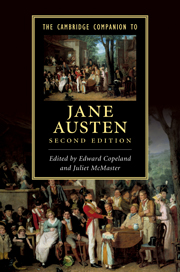Book contents
- Frontmatter
- 1 The Professional Woman Writer
- 2 Northanger Abbey And Sense And Sensibility
- 3 Pride And Prejudice And Mansfield Park
- 4 Emma And Persuasion
- 5 The Early Short Fiction
- 6 ‘Lady Susan’, ‘The Watsons’ And ‘Sanditon’
- 7 The letters
- 8 Class
- 9 Money
- 10 Making a living
- 11 Gender
- 12 Sociability
- 13 Jane Austen and literary traditions
- 14 Jane Austen on screen
- 15 Austen cults and cultures
- 16 Further reading
- Index
- Cambridge Companions to . . .
6 - ‘Lady Susan’, ‘The Watsons’ And ‘Sanditon’
Published online by Cambridge University Press: 28 March 2011
- Frontmatter
- 1 The Professional Woman Writer
- 2 Northanger Abbey And Sense And Sensibility
- 3 Pride And Prejudice And Mansfield Park
- 4 Emma And Persuasion
- 5 The Early Short Fiction
- 6 ‘Lady Susan’, ‘The Watsons’ And ‘Sanditon’
- 7 The letters
- 8 Class
- 9 Money
- 10 Making a living
- 11 Gender
- 12 Sociability
- 13 Jane Austen and literary traditions
- 14 Jane Austen on screen
- 15 Austen cults and cultures
- 16 Further reading
- Index
- Cambridge Companions to . . .
Summary
With the exception of the cancelled chapters of Persuasion, nothing remains of the manuscripts of Austen’s published novels. Yet she seems to have kept copies of the versions she sent to publishers: when she wrote to Crosby and Co. in April 1809 about ‘Susan’, an early version of Northanger Abbey which Crosby had accepted in 1803 but had not published, she offered to supply another copy of the manuscript. So we can assume that she kept copies and that these were jettisoned once the novels appeared in print. In contrast, Jane Austen and her family were tenacious in preserving those works which existed in manuscript but which were never published: among them, her Juvenilia, neatly copied into three notebooks, the ‘Plan of a Novel’ and a large number of miscellaneous poems. Most interesting of these manuscripts are three novels (one complete fair copy and two unfinished drafts): ‘Lady Susan’, ‘The Watsons’ and ‘Sanditon’. These works span Austen’s creative years, from the 1790s when she was still a teenager, to a few months before she died at 41, so they cast a unique light on her creative processes from the beginning to the end of her writing career.
- Type
- Chapter
- Information
- The Cambridge Companion to Jane Austen , pp. 87 - 96Publisher: Cambridge University PressPrint publication year: 2010

